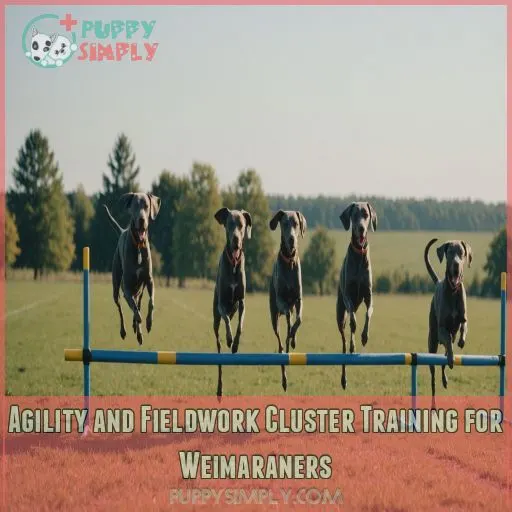This site is supported by our readers. We may earn a commission, at no cost to you, if you purchase through links.

Imagine cluster training as a mental and physical workout combo that builds obedience muscles while preventing your living room from becoming a chew toy haven.
By understanding their energy and intelligence, you can channel your pooch’s inner genius and curb their curious antics.
Ready to learn the secrets that’ll have your Weimaraner thriving? The next steps are tail-wagging exciting!
Table Of Contents
- Key Takeaways
- Weimaraner Traits and Training Challenges
- Fundamentals of Cluster Training for Weimaraners
- Adapting Cluster Training for Weimaraner Energy Levels
- Cluster Training to Address Separation Anxiety
- Channeling Chewing Instincts Through Cluster Training
- Cluster Training for Weimaraner Obedience and Focus
- Agility and Fieldwork Cluster Training for Weimaraners
- Socialization Through Weimaraner Cluster Training
- Monitoring and Adjusting Cluster Training Progress
- Advanced Cluster Training Techniques for Weimaraners
- Frequently Asked Questions (FAQs)
- What is the best training for Weimaraners?
- Are Weimaraners difficult to train?
- What is the daily routine for a Weimaraner?
- Do Weimaraners pick one person?
- How to introduce new Weimaraners to an existing cluster?
- What is the best age to start cluster training for Weimaraners?
- How to deal with aggression within a Weimaraner cluster?
- How to transition from individual to cluster training techniques?
- How to balance individual attention in Weimaraner cluster training?
- Conclusion
Key Takeaways
- Harness your Weimaraner’s energy with cluster training – it’s like mixing an agility course with a brain teaser, perfect for a dog that could double as a furry tornado and learn about clicker training. Short, intense sessions keep their minds sharp and your shoes safe.
- Weimaraners might think they’re your fur-shadow, so tackling separation anxiety is crucial. Start with a cozy crate, gradually ramp up alone time, and toss in some treats to make "solo time" less daunting.
- Turn chewing chaos into constructive play. Arm yourself with durable chew toys and teach "leave it" and "drop it" commands. It’s about channeling that forest of chompers into safe, sanity-saving activities.
- Keep training fresh and fun – combine skills like a conductor orchestrating a canine symphony. Mix obedience drills with scent work and agility, ensuring your Weimaraner stays the life of the training party.
Weimaraner Traits and Training Challenges
You’re about to start a thrilling journey with your Weimaraner, but buckle up—these high-energy pups come with their fair share of challenges.
From their boundless enthusiasm to their separation anxiety and chewing habits, we’ll explore the unique traits that make Weimaraners both lovable and demanding companions.
High Energy Levels and Exercise Needs
With Weimaraners, you’ve got a four-legged powerhouse on your hands. These silver shadows aren’t just pretty faces; they’re built for action.
You’ll need to channel their boundless energy into productive outlets, or your shoes might become their next chew toy.
Think long walks, intense play sessions, and mentally stimulating activities.
Cluster training can be a game-changer, helping you pack a punch in shorter, high-intensity bursts.
Strong Attachment to Owners and Separation Anxiety
Your Weimaraner’s Velcro-like tendencies might be endearing, but they can lead to separation anxiety. These silver shadows crave constant companionship, making alone time a challenge.
Here’s how to help your furry friend cope:
- Start crate training early, creating a safe haven
- Gradually increase alone time, using calming aids if needed
- Enlist a dog walker for midday breaks
Chewing Instincts and Potential Hazards
While Weimaraners crave your company, their strong chewing instincts can spell trouble.
These silver beauties might turn your home into a doggy demolition derby if left unchecked.
From shoes to furniture, nothing’s off-limits – and watch out for rock-chewing! It’s not just your belongings at risk; their dental health is on the line too.
Let’s tackle this challenge head-on with some clever cluster training techniques to redirect that urge to chomp.
Intelligence and Trainability
Weimaraners are whip-smart cookies, but that doesn’t mean they’re a breeze to train.
You’ll find these gray ghosts can pick up commands faster than you can say "sit," but they’ve got a stubborn streak a mile wide.
Their intelligence means they’ll get bored easily, so mix up your training sessions.
Keep ’em short, fun, and challenging – your Weim’s brain is like a sponge waiting to soak up new tricks!
Socialization Requirements
Intelligence isn’t enough for a well-rounded Weimaraner.
These silver beauties need early socialization to shine in any setting.
Think of it as your pup’s social bootcamp: puppy classes, new sights, sounds, and smells.
It’s all about building those social skills and dog park etiquette.
So, let’s get that tail wagging and those paws exploring!
Fundamentals of Cluster Training for Weimaraners
So, you’ve got a lively Weimaraner with training goals. Getting the most out of their potential takes understanding cluster training benefits! Imagine it as a clean pulls workout for your pup—short, intense bursts of focus and agility. You wouldn’t use a barbell stroke on a dog, but the idea’s similar: precision and power.
Cluster training is a powerful tool, but safety is paramount.
- Schedule sessions strategically around the dog’s daily rhythm, much like a competitive phase in human training.
- Swap out straight sets for varied exercises. Just like at a dog show, it keeps things fresh and exciting.
- Make sure cluster training is safe by starting simple—no need for flipping through flaming hoops!
Get ready for effective sessions that transform chaos into controlled enthusiasm. It’s training with flair!
Adapting Cluster Training for Weimaraner Energy Levels
Harnessing your Weimaraner’s boundless energy with cluster training is like turning a whirlwind into a well-directed breeze by learning about cluster training principles.
Just remember to balance bursts of high-intensity play with well-deserved rest breaks to keep them, and yourself, from feeling more out of breath than a dog chasing its tail!
Designing High-intensity Intervals
To keep your Weimaraner’s energy in check, blend excitement with strategy.
Start with short interval durations and mix up the exercise selection, throwing in block snatches for variety.
Adjust the work-to-rest ratio carefully, spicing up intensity variations to challenge without overwhelming them.
It’s like crafting a fine recipe—balanced ingredients lead to a delightful outcome!
Incorporating Rest Periods for Optimal Performance
Weimaraners thrive on activity, but don’t forget the all-important rest periods.
Strategically schedule breaks to let your pup recharge between cluster sets.
Too much intensity without a breather can backfire, leading to fatigue and disengagement.
Find the sweet spot – enough challenge to keep them motivated, with ample recovery time to perform their best.
Balancing Physical and Mental Stimulation
After incorporating rest periods, balancing physical and mental stimulation is key.
Keep these high-energy pups engaged:
- Mental Enrichment: Use puzzle toys and scent games to challenge their minds.
- Interactive Play: Tug-of-war or fetch satisfies both energy and curiosity.
- Training Challenges: Mix obedience drills with fun.
Watch your Weimaraner thrive as you harness their boundless zest!
Monitoring Fatigue and Recovery
Balancing a Weimaraner’s vigor with proper rest feels like walking a tightrope.
Keep an eye on their sleep, hydration, appetite, energy levels, and muscle soreness to gauge fatigue and recovery.
| Factor | Check Regularly | Action Needed |
|---|---|---|
| Sleep | Daily | Provide downtime |
| Hydration | Next Walk | Provide water |
| Appetite | Each Meal | Evaluate diet |
| Energy Levels | During Play | Adjust exercise |
| Muscle Soreness | After Training | Offer massages |
Listen to their needs like a patient telepath!
Cluster Training to Address Separation Anxiety
You know how your Weimaraner hates being left alone, right?
Let’s tackle that separation anxiety with some clever cluster training,
so your dog starts to chill while you’re out conquering the world.
Gradual Desensitization Techniques
Tackling separation anxiety takes patience, but gradual desensitization is key. Start with short bursts of alone time, rewarding calm behavior. 1. Introduce the crate as a cozy den, not a punishment. 2. Expose your pup to noise when you’re home, so silence doesn’t trigger panic. 3. Slowly build up their tolerance for solo adventures.
Building Independence Through Cluster Exercises
Think of building your Weimaraner’s independence like teaching a kid to ride a bike.
Start small: crate training helps with separation anxiety.
Practice short stints of alone time, mixed with solo play, to boost confidence.
Gradually extend their "me time."
This approach helps ease anxiety and promotes a healthier, happy dog.
You’ve got this—it’s dog-owner teamwork!
Incorporating Positive Reinforcement
Moving from independence-building exercises, incorporating positive reinforcement in cluster training can help soothe your Weimaraner’s anxiety, especially when focusing on intra-set rest periods. Treat-driven motivation works wonders.
Try these:
- Use reward-based training to shape desired behaviors
- Lean on clicker training techniques for clear communication
- Praise with treats to reinforce calm alone-time
- Keep it fun—after all, who doesn’t enjoy a tasty reward?
Creating a Safe Space During Training
After using positive reinforcement, create a safe, quiet zone for your Weimaraner.
Imagine it as their personal zen zone—cozy, distraction-free, where anxiety doesn’t stand a chance.
Include their favorite blanket or toy.
Bits of tasty treats can work wonders here!
This retreat helps your pup feel secure and loved, reducing their anxiety while you gradually step out of sight.
Channeling Chewing Instincts Through Cluster Training
Weimaraners are notorious for their insatiable chewing habits, but you can channel this instinct into productive cluster training sessions.
By incorporating chew toys and teaching "leave it" and "drop it" commands, you’ll redirect their energy into safe, constructive activities that build focus and obedience.
Redirecting Chewing Behavior to Appropriate Objects
Weimaraners, with their energetic chewing instincts, can munch on everything from shoes to remote controls.
To redirect these antics, provide safe alternatives with strategic chew toy selection.
Maintain training consistency by rewarding good choices, reinforcing positive behavior.
A creative reward system, like swapping forbidden items for approved ones, can stop these furry mischief-makers.
Chewing prevention’s all about clever redirection!
Incorporating Chew Toys in Training Sessions
Chew toys can be your secret weapon in cluster training—like giving socks with rockets to distract that chewing trait! Use them wisely:
- Toy Selection: Choose durable toys for safety but avoid ones that look like shoes!
- Timing: Introduce toys during potential chew-frenzy moments.
- Rewards: Praise lavishly when they choose toys over furniture.
Cluster training wins, right?
Teaching Leave It and Drop It Commands
Mastering the "Leave It" and "Drop It" commands with your Weimaraner is like having a magic wand for mischief control.
Start training by using positive reinforcement with a tempting chew toy.
Show consistency and patience; it’s all about maintaining the upper hand as the leader.
Reward progress with treats and praise, and soon you’ll have a rock-solid, distraction-controlling duo!
Preventing Destructive Chewing Through Mental Stimulation
Don’t let those pesky chewing habits get you down!
Harness your Weimaraner’s natural curiosity with engaging mental stimulation.
Puzzle feeders, interactive toys, and training games can channel that energy into positive outlets.
Swap out those rocks for chew-approved goodies and watch your pup’s destructive tendencies melt away.
You’ve got this – with a little creativity, you can curb that chewing in no time!
Cluster Training for Weimaraner Obedience and Focus
Training your Weimaraner to focus can feel like convincing a squirrel to stay still, but with cluster training, it becomes an achievable task.
Embrace short, intense obedience drills to channel their spirited energy, even when distractions pop up like uninvited guests.
Short, Intense Obedience Drills
After channeling the Weimaraner’s chewing instincts, let’s tackle obedience with short, intense drills.
Focus is key—like herding cats, minus the furballs.
Aim for five-minute bursts packed with commands.
Introduce simple distractions to test resolve, but maintain consistency.
Feel free to offer treats for a strong recall.
You’ll soon have a model citizen on four paws!
Increasing Duration and Complexity Over Time
Increasing the complexity over time turns your Weimaraner into an obedience champ! You’ll see progress with these steps:
- Progressive Training: Gradually escalate commands from basic to advanced exercises.
- Challenge Progression: Add new skills as each is mastered; think of it as leveling up in a game.
- Skill Development: Extend sessions while keeping them fun—like a workout mix for your dog!
Incorporating Distractions in Training Sessions
Spice up your Weimaraner’s cluster training by incorporating distractions like those found in puppy socialization!
Gradually expose your pup to real-world scenarios – from bustling streets to noisy playgrounds.
Use positive reinforcement to keep them focused, and don’t be afraid to get creative with environmental enrichment.
With patience and practice, your Weimaraner will learn to thrive in any situation.
Building a Strong Recall Command
You’ve mastered distraction training, now focus on building a strong recall command.
Think of it like teaching your Weimaraner their "get back here!" signal.
Here’s how to nail it:
- Start small: Begin in a quiet room.
- Use positive reinforcement: Reward their return.
- Gradually increase distance control: Consistency matters in real-world practice.
Stay patient!
Agility and Fieldwork Cluster Training for Weimaraners
Boost your Weimaraner’s agility and fieldwork skills by setting up exciting cluster training sessions that mimic real-world scenarios, like using a crate for safe and secure training.
You’ll soon see your energetic pup zip through obstacles with speed and precision, making every training day feel like an adventure.
Setting Up Agility Courses for Cluster Sessions
To keep your Weimaraner sharp, agility course design is your ally! Start with simple obstacles, choosing equipment like tunnels and jumps suited to their boundless energy.
Safety considerations are key—ensure firm, stable layouts.
Progression planning lets you up the ante as skills improve. Embrace curiosity through Weimaraner-specific obstacles, making each training session an exciting new adventure.
Simulating Fieldwork Scenarios in Short Bursts
Weimaraner owners, get ready to put your pup’s nose to the test! Simulate thrilling fieldwork scenarios with short, intense bursts of scent work and tracking drills.
Incorporate retrieve practice and navigate agility obstacles to keep your Weim’s mind sharp.
Don’t forget the off-leash scenarios – they’ll love the freedom to explore and problem-solve.
Improving Speed and Precision in Obstacle Navigation
Handling obstacles with a Weimaraner takes finesse and a dash of humor.
Picture timing strategies as your secret sauce!
Design agility courses with twists and turns; keep them guessing!
Focus training is your anchor, and reward systems are your lifeline.
Practice often, sprinkle in enthusiasm, and watch those paws fly through hurdles like a graceful whirlwind.
It’s teamwork magic!
Building Endurance for Longer Work Periods
Once your Weimaraner has mastered speed and precision, it’s time to up the ante with interval training.
Picture it like a dance—perfect work-rest ratios make sure they’re not left gasping for breath.
Gradually embrace progressive overload, aiming for longer sessions.
Don’t forget recovery strategies and hydration needs—all part of their endurance toolkit.
Keep pushing, but know when to let them rest.
Socialization Through Weimaraner Cluster Training
With their boundless energy and spirited curiosity, Weimaraners benefit from cluster training to socialize and explore the world.
You’ll love watching your “gray ghost” transform hubbub-filled situations into no-big-deal moments, wagging their tail like they own the place.
Exposure to Various Environments and Stimuli
Exposing your Weimaraner to a variety of environments and stimuli during their formative puppyhood is really important for their socialization. From bustling city streets to serene nature trails, get them comfortable with different sights, sounds, and smells.
Don’t be afraid to get creative – the more diverse their experiences, the better-adjusted they’ll be.
Controlled Interactions With Other Dogs and People
After familiarizing your Weimaraner with new environments, focus on controlled interactions with other dogs and people. Think of it like hosting a dinner party but with less food on the floor.
Socialization tips include:
- Practicing dog park etiquette
- Managing leash reactivity
- Encouraging off-leash play
- Joining group training sessions
- Keeping interactions short and sweet
Building Confidence in New Situations
As you introduce your Weimaraner to new environments, think of yourself as their tour guide, using socialization as a tool for confidence-building.
Exposure therapy, paired with positive reinforcement, helps them see new situations as opportunities, not obstacles.
Every small win is a step toward desensitization and fear reduction.
Addressing Fear or Reactivity Issues
Taming a Weimaraner’s fear is like unraveling a mystery, one paw at a time. Identify fear triggers and use desensitization methods paired with positive reinforcement.
Create safe havens where your dog feels secure.
Consistent reactivity management boosts confidence.
Monitoring and Adjusting Cluster Training Progress
Tracking your Weimaraner’s progress is key to fine-tuning their cluster training.
Stay on top of their behavior and obedience improvements, then adapt the intensity and duration as needed – you don’t want to overdo it and risk a setback.
Incorporating new challenges will keep your pup engaged and continuously building those essential skills.
Tracking Improvements in Behavior and Obedience
Just like you wouldn’t forget your kid’s first steps, monitor your Weimaraner’s progress consistently. Use simple tools and your phone’s note app to track:
- Improvements in behavior and obedience.
- Celebrate with rewards—hooray for positive reinforcement!
- Consistency can work magic, so don’t lose heart. Keep practicing, adjusting, and enjoying the newfound harmony in your household.
Adapting Training Intensity and Duration
For Weimaraner fitness, tweak your training schedule by considering their age and individual needs.
Puppies might need shorter bursts, while adults enjoy longer sessions.
Balance owner time and your dog’s energy by gradually increasing intensity.
Keep an eye on their enthusiasm; no need to turn them into couch potatoes or marathon runners.
Tailor each session like a custom-made suit.
Addressing Plateaus and Setbacks
Hitting a plateau in your Weimaraner’s training is like running into a brick wall—you’ve got to figure a way over it!
Regain motivation by mixing things up; try alternative methods to keep their interest.
Consistency is key, but approach with flexibility.
Adjust the training routine and seek fellow owner support to spark both your passions.
Incorporating New Challenges as Skills Improve
As your Weimaraner’s skills sharpen, it’s time to up the ante! Incorporate new challenges that build on their growing expertise.
Here are 4 ways to keep them engaged and progressing:
- Introduce complex obedience commands.
- Expand agility courses with tricky obstacles.
- Try scent work exercises in varied environments.
- Compete in fun, low-pressure trials to showcase their talents.
Challenging your Weimaraner keeps them mentally stimulated and strengthens the bond you share. Embrace their willingness to learn and watch them soar!
Advanced Cluster Training Techniques for Weimaraners
Help your Weimaraner reach their full potential with advanced cluster training techniques designed to combine skills and build confidence in diverse environments. Learn about using rewards effectively.
These exercises will keep your energetic companion engaged and ready to learn.
Whether you’re prepping for a friendly competition or teaching scent work, these exercises will keep your energetic companion engaged and ready to learn.
Combining Multiple Skills in Single Sessions
You’ve got the hang of monitoring your Weimaraner’s progress; now, let’s tackle combining multiple skills in one session!
Think of it like a three-ring circus where agility, obedience, and fieldwork take center stage.
Juggling these activities keeps your dog sharp and engaged, kindling their inner superhero.
Off-leash Cluster Training in Various Environments
Taking your Weimaraner off-leash can feel like letting a kite loose in a tornado, but with the right approach, it’s a breeze!
Focus on recall and handling distractions in varied environments.
Consistent practice enhances off-leash safety and fosters social interaction.
Incorporating Scent Work and Tracking Exercises
Boost your Weimaraner’s natural scenting abilities by incorporating scent work and tracking exercises into your cluster training regimen. These activities tap into their innate hunting instincts, providing mental stimulation and strengthening the bond between you and your furry companion.
- Start with simple scent discrimination games using familiar household items.
- Invest in quality tracking equipment like long leashes and harnesses.
- Gradually increase the complexity of tracking challenges to keep your Weimaraner engaged.
- Use high-value treats and praise to motivate and reward their efforts.
Preparing for Competitive Events and Trials
Congratulations on mastering scent work!
Now, you’re ready to tackle competitive events and trials.
Think of it as the Weimaraner’s Olympics—packed with adrenaline and fun!
Remember to tailor competition preparation with trial strategies in mind.
Focus on event logistics, managing performance anxiety, and establishing recovery protocols.
Your dedicated teamwork, these moments will become unforgettable victories.
Frequently Asked Questions (FAQs)
What is the best training for Weimaraners?
Imagine a whirlwind of energy, on a quest for fun!
Channel your Weimaraner’s boundless enthusiasm into obedience training, agility courses, or fieldwork.
Keep it exciting and interactive, and you’ll master their attention and nurture their loyalty.
Are Weimaraners difficult to train?
Training Weimaraners can be a bit like herding cats, thanks to their high energy and stubborn streak.
Patience, consistency, and a sense of humor go a long way.
Engage them with activities to focus their energy.
What is the daily routine for a Weimaraner?
Start with morning exercise to burn energy, then engage them with interactive toys or training.
After lunch, enjoy companionship through walks or play.
Avoid leaving them alone too long to prevent mischief—remember, they love being your shadow!
Do Weimaraners pick one person?
Weimaraners are known to form a deep bond with their owners, often sticking to one person like glue.
In fact, 9 out of 10 Weimaraner owners report their pup prefers their company over anyone else’s.
How to introduce new Weimaraners to an existing cluster?
Introducing a new Weimaraner? Make the process smooth by gradually acclimating them into the existing group.
Focus on supervised interactions, engage them with shared activities, and reward positive behavior.
Patience is key—think of it as organizing a successful family reunion.
What is the best age to start cluster training for Weimaraners?
Think of cluster training like teaching a young wizard their first spell.
Start around 12-18 months when their attention span matures a bit.
They’ll learn better if you’re patient, focusing on fun, short bursts of practice.
How to deal with aggression within a Weimaraner cluster?
Encountering aggression in a Weimaraner cluster? Stay calm and assertive.
Use positive reinforcement to reward good behavior, involve a professional trainer if needed, and make sure they get enough physical and mental exercise.
Patience is key!
How to transition from individual to cluster training techniques?
Rome wasn’t built in a day, so don’t sweat the move from individual to cluster training.
Take it one step at a time, and soon you’ll be a cluster training pro, reaching your full potential.
How to balance individual attention in Weimaraner cluster training?
Balance individual attention by tailoring exercises to your Weimaraner’s energy bursts using cluster training.
Create short, focused sessions with rest breaks, treating each like a mini-adventure in control.
It’ll energize their tail and your training.
Conclusion
Picture your Weimaraner gleefully engaging in productive play as you learn the secrets of the Weimaraner cluster training guide.
With some patience and creativity, you’ll transform their zest for life into a wellspring of obedience and focus.
Whether tackling separation anxiety or curbing chewing instincts, cluster training offers the ideal blend of fun and discipline.
Start now, craft a routine, and watch your furry friend thrive as they master new skills with boundless enthusiasm!
















